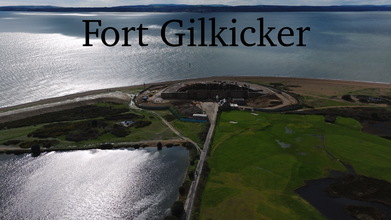
Interested In This Footage?
Fort Gilkicker
- over 1 year ago
- 100 VŪZ
4 



- 4
- Report
Fort Gilkicker is a historic Palmerston fort built at the eastern end of Stokes Bay, Gosport, Hampshire England to dominate the key anchorage of Spithead. It was erected between 1863 and 1871 as a semi-circular arc with 22 casemates, to be armed with five twelve-inch guns, seventeen ten-inch guns and five nine-inch guns. The actual installed armament rather differed from this. In 1902 the RML guns were replaced by two 9.2-inch and two six-inch BL guns, and before the First World War the walls were further strengthened with substantial earthwork embankments. The fort was disarmed in 1956 and used for storage until 1999, and is currently in a state of disrepair. Layout A plan of the New Fort Gilkicker showing the original layout of the gun casemates with the barrack block behind Each of the twenty two gun casemates on the main gun floor consists of a brick vaulted chamber behind a granite face fourteen feet thick. Each gun fired though an armoured embrasure with a shield hung on a massive shield frame. To the rear of each gun casemate is the barrack room for the gun crew with space for folding barrack room beds and a fireplace. The barrack rooms open on to a verandah, or walkway, that connects all of the barrack rooms. Beneath the gun casemates are a series of magazines appropriated for shells and cartridges. Vertical lifts from the shell and cartridge passages open onto each gun casemate allowing efficient supply of ammunition for the guns. The magazine floor was lit by oil lamps placed on lamp trolleys running on rails through lamp tunnels from the parade. Steps lead up from the verandah and parade to the upper battery that consisted of five large open gun emplacements with expense magazines between. The rear, or gorge, of the fort is closed by a two-storey barrack block that was originally occupied by the officers. It included Officer's bedrooms, the officers’ mess with kitchen and pantry, a field officer's quarters, and officer's servant's quarters. At each end was an artillery store. At the western end was the laboratory for filling shells and cartridges. The entrance to the fort through the centre of the barrack block opens onto the central parade. Outside the fort is an artillery store and a smith and fitters shop.[1] History Original battery (1853-1863) The first fortifications on Gilkicker Point were constructed as an auxiliary battery to Fort Monckton and consisted of an earthen rampart for eleven guns firing through embrasures cut through the parapets. The battery was a distorted quadrilateral in shape with a long gorge (or rear) a short sea facing rampart with two flanking faces. The front faces were protected by a ditch which was flanked by musketry caponiers at the angles. The rear was closed off by a brick wall with a barrack for officers at its centre.[2] The battery was heavily criticised by James Fergusson, who eventually became the Treasury representative on the Royal Commission in to the defences of the United Kingdom, set up in 1859. In his paper ‘The Peril of Portsmouth’[3] he stated that the battery was in danger of collapse under the weight of its own guns and could easily be captured by a small force landing in the bay as it could offer little resistance. As a result, the Defence Committee proposed a new work to replace it. https://en.wikipedia.org/wiki/Fort_Gilkicker #dji #history #construction #development #drone
Up Next
Portchester Castle at Sunrise by DJI Mavic 3 PRO

- SouthCoastDronesUK
- 617 VŪZ
7 - 9
- almost 2 years ago
Portsmouth Night View

- SouthCoastDronesUK
- 1.0k VŪZ
0 - 0
- over 1 year ago
The Watercress Line

- SouthCoastDronesUK
- 914 VŪZ
0 - 0
- over 1 year ago
DJI Mavic 3 PRO 5.1k Presents: Arundel Castle's Icy Charm in the Mist

- SouthCoastDronesUK
- 1.5k VŪZ
2 - 2
- almost 2 years ago
Stonehenge at Sunrise on a Misty Sunday Morning - Shot on a DJI Mavic 3 PRO 5.1k 50fps

- SouthCoastDronesUK
- 2.0k VŪZ
10 - 16
- almost 2 years ago
HMS Montrose F236 - HMS Monmouth F235 - Hardway Gosport - Waiting to be scrapped.

- SouthCoastDronesUK
- 664 VŪZ
8 - 9
- almost 2 years ago
Our Adventure to Wales - A View of Wales From The Sky -DJI Mavic 3 PRO & DJI Mini 3 PRO

- SouthCoastDronesUK
- 1.7k VŪZ
9 - 12
- almost 2 years ago
Longford Castle

- SouthCoastDronesUK
- 872 VŪZ
7 - 12
- over 1 year ago
HMS Queen Elizabeth Leaving Portsmouth Harbour

- SouthCoastDronesUK
- 1.0k VŪZ
9 - 11
- almost 2 years ago
Titchfield Abbey on a Cold Frosty Winters Morning at Sunrise - 5.1k 50Fps - DJI

- SouthCoastDronesUK
- 1.1k VŪZ
7 - 11
- almost 2 years ago